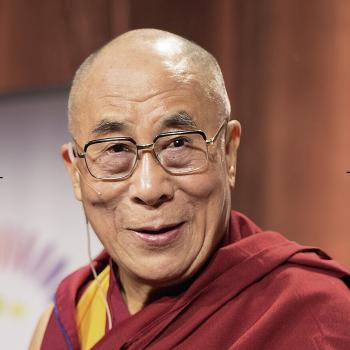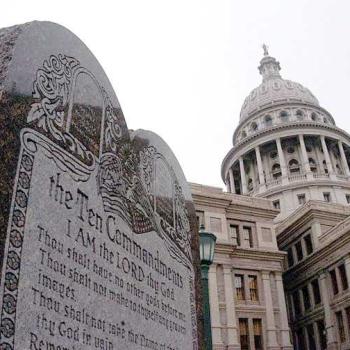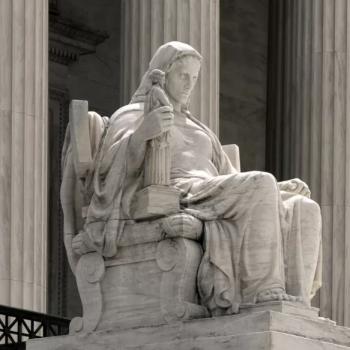I’ve written a number of columns looking at issues involving religion and the U.S. Constitution. The last one, Jefferson’s Wall of Separation Between Church and State, explains the history behind the (in)famous “wall of separation” phrase and what it means. But a lot of Americans are enraged by Thomas Jefferson’s church and state metaphor, which he used to explain the religion clauses of the First Amendment to the Constitution — “Congress shall make no law respecting an establishment of religion, or prohibiting the free exercise thereof.” What are the objections to the wall of separation between church and state?
“Wall of Separation Between Church and State” Is Not in the Constitution
The most common objection is that the words “wall of separation between church and state” don’t appear in the Constitution. However, as explained above and here, “wall of separation between church and state” is a metaphor used by Thomas Jefferson to explain the meaning of the establishment and free exercise clauses of the First Amendment, which do appear in the Constitution. It isn’t unusual, or out of line, for judges to borrow from the writings of the founders to explain constitutional principles and make these writings part of case law.
And as explained in several Religious History Nerd columns, Thomas Jefferson and James Madison were the two founders most responsible for defining religious liberty and the proper relationship between church and state during the Revolution and in the early days of the United States. James Madison — who was called “the father of the Constitution” by his peers — was in fact the author of the First Amendment, and he and Jefferson were of one mind on the matter of religious liberty. Any honest reading of American history would tell us that the First Amendment means whatever Madison and Jefferson said it means.
The United States Is a Christian Nation
No, it isn’t. See The Myth of the Christian Nation for the details. In brief, the Constitution was deliberately written to make the United States a secular nation that cannot declare any religion to be the “official” one.
It’s true that Christianity is the majority religion in the United States. It’s true that Christianity has played a role in U.S. history and culture (although so has Judaism). However, one of the bedrock principles of civil rights is that a majority cannot ignore the rights of minorities. James Madison made this point in “Memorial and Remonstrance against Religious Assessments.” And in Federalist No. 10, he wrote that “measures are too often decided, not according to the rules of justice and the rights of the minor party, but by the superior force of an interested and overbearing majority.”
The whole point of removing “establishment of religion” as a power of Congress in the First Amendment is to protect minorities, including non-Christians and atheists, from the overbearing Christian majority. Even though a majority of Americans may self-identify as Christian, the Constitution says that this majority may not use the government to compel others to say Christian prayers or engage in Christian observances.
No Compulsion, No Church and State Problem
One commonly used argument heard in school prayer and similar church and state cases is that if individuals may opt out of the prayer without compulsion or pressure, then no one’s First Amendment rights are violated. That was the gist of Justice Potter Stewart’s dissent in the Everson v. Vitale (1962) case, discussed in more detail here.
But the Everson case involved a supposedly non-sectarian prayer that was written by the state of New York for classroom use. The majority thought that government had no business composing prayers and recommending that children say them, even if refusing was an option. And considering that some religious groups objected to the prayer, it must not have been all that non-sectarian. (I personally don’t think there could be such a thing as a non-sectarian prayer. Even if you could compose a prayer that the Abrahamists — Jews, Christians, Muslims — could agree on, which I doubt, I can promise you Buddhists and Hindus wouldn’t want to say it.)
Consider also what it might be like to be the one child in a third-grade class who is sent into the hall every day before the class prayer. Even if the teachers aren’t being coercive, the child will still pay a social price.
It’s not Coercion If It’s Exclusion
The issue of coercion has come up in other Supreme Court cases involving the relationship between church and state. One such case began in 1986 when the Weisman family of Providence, Rhode Island, attended young Merith Weisman’s middle school graduation ceremony. The ceremony opened with a Baptist minister saying, “Please rise and praise Jesus for the accomplishments of these children today.” And then the minister launched into a very Christian prayer.
The Weismans and other Jewish families present were made very uncomfortable. They felt the prayer crossed a line. And in Lee v. Weisman (1992), the Supreme Court ruled that clergy may not say prayers as part of public school graduation ceremonies. Lawyers for the school district argued that no one coerced the Weismans to attend the graduation ceremony, so their rights were not violated. Justice Anthony M. Kennedy shot that proposal down. “In our culture, a graduation is a key event in the young person’s life,” he said. Public school students should not have to exclude themselves from their own graduations to avoid a Praise-to-Jesus revival.
The Decision From an Alternative Reality
More recently, the Supreme Court knocked some bricks out of the wall between church and state in Kennedy v. Bremerton School District (2022). In this case, a public high school football coach of Bremerton, Washington, named Joseph Kennedy used “motivational prayers” as part of his coaching. These included prayers when players were gathered in the locker room and in the middle of the field after each game. The post-game prayers in particular became big spectacles when players from both teams rallied around the coach to join in. Then the coach used the opportunity to deliver “talks” with religious content that arguably amounted to sermons.
One parent complained to the school district that his atheist son “felt compelled to participate.” despite being an atheist. The student feared “he wouldn’t get to play as much if he didn’t participate.” Members of the community also complained. The school district asked the coach to stop the public group prayers and sermons. If he wanted to say his own prayers somewhere on school property that’s fine, but he had to leave the students out of it. When Coach Kennedy refused to comply, he was fired.
The Supreme Court sided with the coach on this one. But Justice Neil Gorsuch, who wrote the majority opinion, changed the facts of the case to arrive at his conclusion. In Justice Gosuch’s version of events, the coach was fired for praying privately on school property. The coach “offered his prayers quietly while his students were otherwise occupied,” the justice wrote, which was not what was happening. The school district had even submitted pictures of the football players kneeling around the coach on the field. The ruling, basically, says that there is no church and state violation in the case because Neil Gorsuch said there isn’t. Where that leaves us with church and state issues going forward isn’t clear.
Religion Isn’t Necessarily Religion
This is the weirdest one, but it’s been tried. For example, the attorneys representing the school district in Abington School District v. Schempp (1963) tried to argue that the Bible is not an inherently religious text. In this case, the state of Pennsylvania required public school classes to recite or listen to Bible verses every day, and after this they were to recite the Lord’s Prayer. The children could interpret the Bible verses any way they liked, the lawyers said, so this was not a case of Pennsylvania promoting religion. The Supreme Court didn’t buy it, either. (See The Problem With Bible Readings in Public Schools.)
And then there were the arguments in Salazar v. Buono (2010) in which Justice Antonin Scalia claimed that a Cross is not necessarily Christian. This case involved a Latin Cross erected by private citizens on federal property, the Mojave National Preserve, to honor American soldiers killed in war. Frank Buono, a retired Park Service employee, thought that the cross’s placement on federal land violated the establishment clause of the First Amendment, and he asked that it be removed. The memorial excluded Jewish and other non-Christian soldiers, Buono said.
In arguments, Justice Antonin Scalia denied that a Cross only honored Christian war dead. The Cross is just a common memorial symbol, he said. It doesn’t just represent Christianity. Justice Anthony M. Kennedy’s majority opinion carefully avoided addressing the religious aspects of the case directly. But in effect the Court decided 5-4 that the Cross was not intended to send a Christian message.














